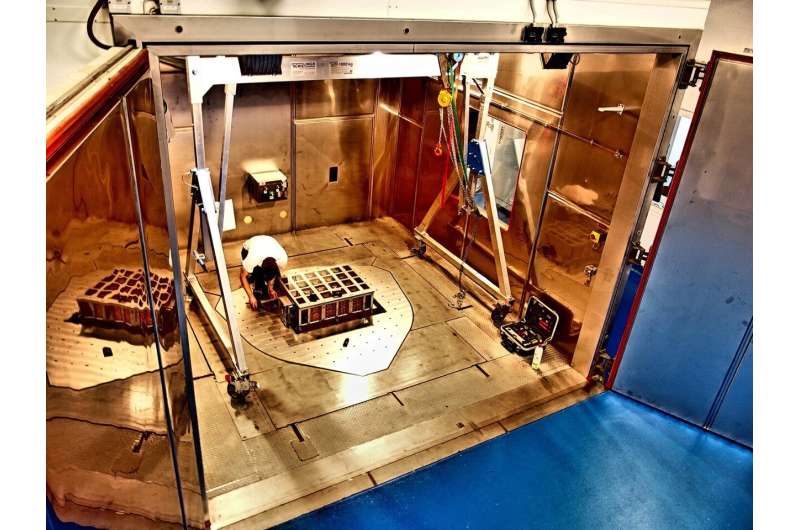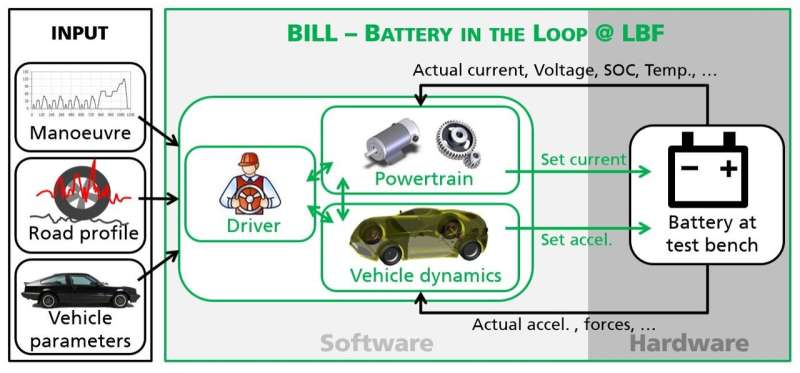Realistic lab tests for e-vehicle batteries

Thorough testing is paramount to the safety and reliability of the batteries that power electric vehicles. However, the lab tests conducted to date have been anything but realistic. Fraunhofer researchers have developed a new type of testing environment that combines physical components with mathematical simulations of vehicles. This setup is the first to enable lab trials under real-world conditions.
Electric vehicle batteries, often called traction batteries, are key components of e-cars. Storing the energy supplied by charging stations and providing that motive power on demand is just one side of their performance equation. The other is to hold up to the wear and tear of electrical, mechanical and thermal stress when negotiating hairpin bends, bouncing over gravel roads strewn with potholes and motoring in the sweltering summer heat. This is why new battery systems have to prove their mettle in various tests before they may be installed in vehicles. However, conventional lab tests are a far cry from reality, and real-world trials have to wait until engineers deliver a drivable prototype of the vehicle. If undetected problems surface at that late a stage, then the necessary modifications can cost a lot of time and money.
The crossroads where the simulation and test bench meet
Researchers at the Fraunhofer Institute for Structural Durability and System Reliability LBF in Darmstadt have developed an alternative in a project called MEF-BILL, which is short for Battery in the Loop @ LBF. "We are now bringing the road into the laboratory and combining our multi-physical testing rig with a computational vehicle simulation. This means we can test batteries under realistic conditions before a prototype vehicle physically exists," says Dr. Riccardo Bartolozzi, the resident expert on numerical system simulation at Fraunhofer LBF. "This way, we gain a lot of time in the development process and significantly improve the quality of results." The loads placed on batteries can be broken down into three domains—the electrical loads primarily attributable to current flows, the vehicular motion, and the climatic aspects. The conventional approach has been to test these three factors separately in lab with trials that have standard runtimes. In the real world, however, these factors are interdependent and affect each other in complex ways. Experts test these loads and their interaction simultaneously in the Fraunhofer LBF testing environment. They have also integrated a real-time-enabled, computerized model of the vehicle into this environment. This way, the researchers can simulate the vehicle and its performance on very different types of roads. This simulation enables them to determine the loads that would also affect the battery in the actual conditions prevailing out there in the real world.
In the past, lab tests have usually been carried out with a battery current profile that follows an idealized curve. This curve looks a lot different in reality. Its trajectory is highly dynamic with random variations, spiking unpredictably as the load peaks. This is why researchers first have to determine the test conditions. What type of vehicle is this battery powering? How heavy is its payload? At what speed does it travel? Is the road's surface flat and smooth or dotted with potholes? The simulation factors all this information into the equation as it calculates the loads placed on and the current fed into the tested battery. The experts who conduct these trials also take complex interactions into account. For example, the amount of initially required power can vary as the temperature in the battery or other parameters change. The researchers constantly track the battery's actual parameters and feed these readings back into the simulation. This circular give-and-take is why trials like this have come to be know as hardware-in-the-loop tests. The input data does not remain static throughout the duration of the test. Instead, it is adjusted on the fly based on data sourced from the simulation and readings taken from the battery. "We can reproduce realistic driving maneuvers in our test scenarios, for example driving uphill or downhill or around sharp bends," says Bartolozzi. The researchers can investigate how other variables affect performance, for example, to determine what happens when an added load increases the vehicle's mass by 20 percent. Shake tests are also performed, using a vibration table actuated by six hydraulic cylinders that can move it in any direction, to mimic the impact on the battery of movements of the vehicle chassis.

The real-time challenge
One of the great challenges for hardware-in-the-loop tests is that the simulation has to run in real time. For example, if a test is conducted to investigate ten seconds of operation, the entire simulation may not take a moment longer than ten seconds. After all, this is a loop where the results of the simulation have to be plugged right back into the test to update the simulation on the fly as the trial progresses. The researchers have fine-tuned the calculation's complexity for this to work. "We ran the simulations at varying levels of complexity to strike the best balance between complexity and computing time," says Bartolozzi. The system is ready for use and preparations for the final demonstration are underway.

















